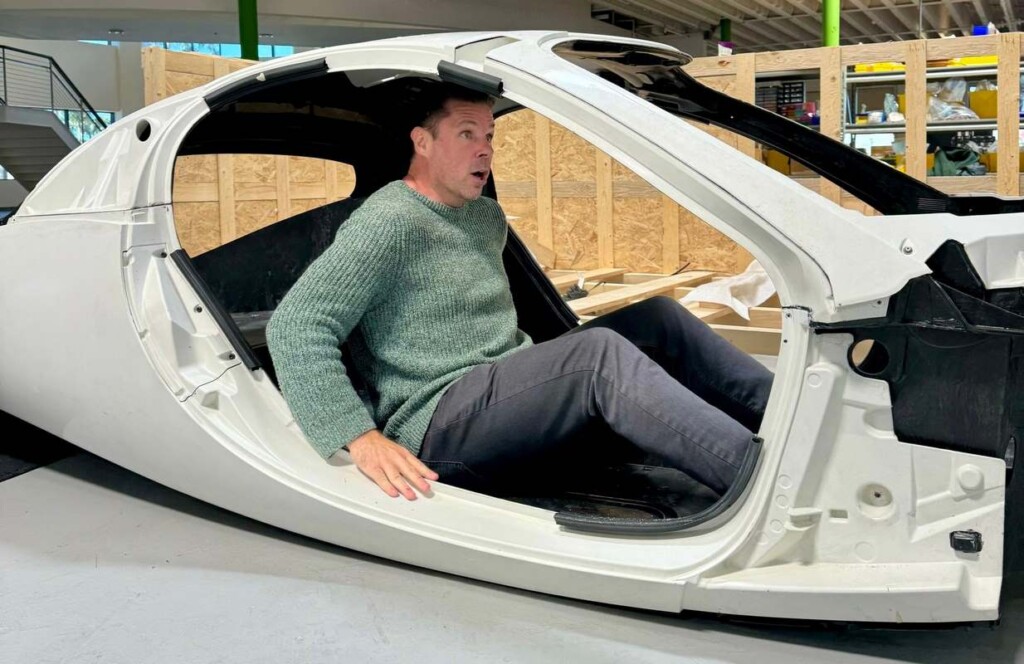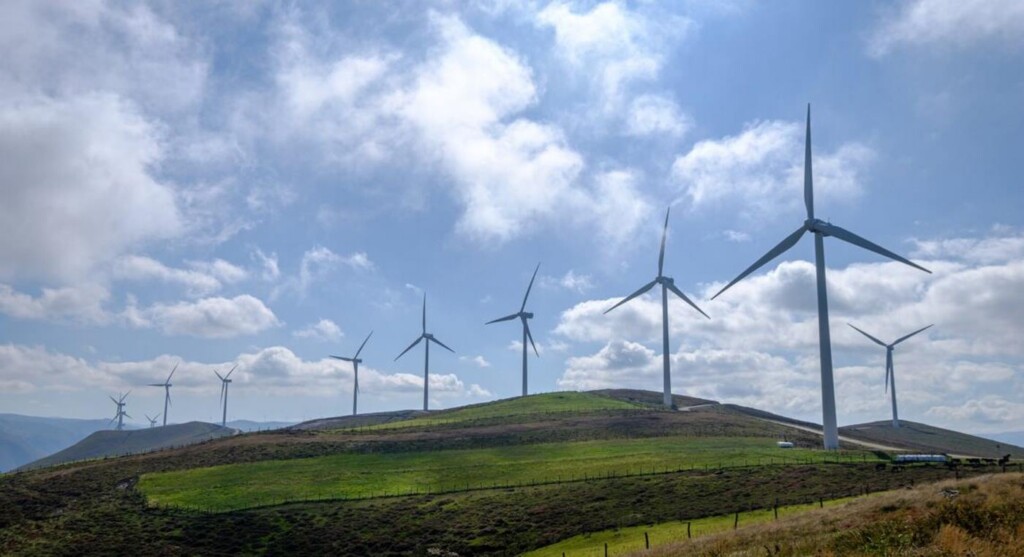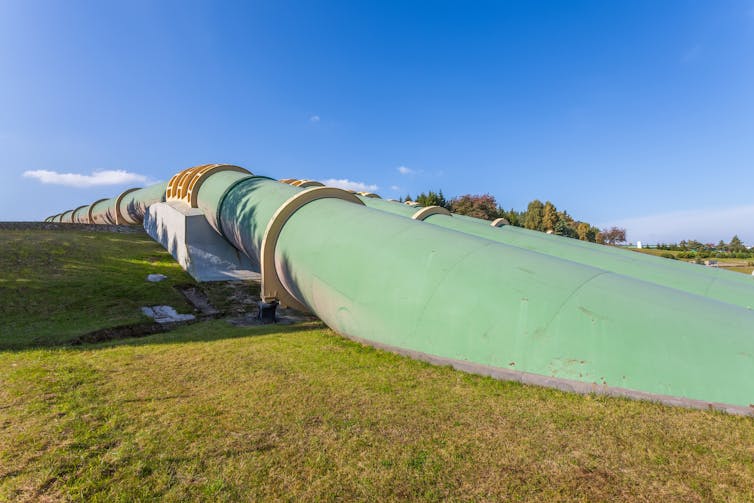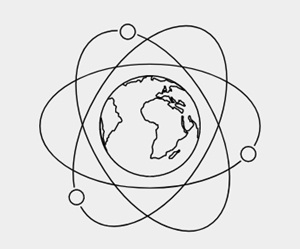.jpg?ext=.jpg)
China starts mass production of carbon-14 isotope
.jpg?ext=.jpg)
Nuclear's role in reaching climate targets recognised by G7
.jpg?ext=.jpg) The meeting of the G7 ministers (Image: G7 Italia)
The meeting of the G7 ministers (Image: G7 Italia)The Car Fueled Entirely by the Sun Takes Huge Step Towards Production
 credit – Aptera, via X
credit – Aptera, via XIncredible 60% of Europe’s Electricity Was Powered by Clean Energy in the First Two Months of 2024

Researchers found 37 mine sites in Australia that could be converted into renewable energy storage. So what are we waiting for?
 Shutterstock
Timothy Weber, Australian National University and Andrew Blakers, Australian National University
Shutterstock
Timothy Weber, Australian National University and Andrew Blakers, Australian National UniversityThe world is rapidly moving towards a renewable energy future. To support the transition, we must prepare back-up energy supplies for times when solar panels and wind turbines are not producing enough electricity.
One solution is to build more pumped hydro energy storage. But where should this expansion happen?
Our new research identified more than 900 suitable locations around the world: at former and existing mining sites. Some 37 sites are in Australia.
Huge open-cut mining pits would be turned into reservoirs to hold water for renewable energy storage. It would give the sites a new lease on life and help shore up the world’s low-emissions future.
The benefits of pumped hydro storage
Pumped hydro energy storage has been demonstrated at scale for more than a century. Over the past few years, we have been identifying the best sites for “closed-loop” pumped hydro systems around the world.
Unlike conventional hydropower systems operating on rivers, closed-loop systems are located away from rivers. They require only two reservoirs, one higher than the other, between which water flows down a tunnel and through a turbine, producing electricity.
The water can be released – and power produced – to cover gaps in electricity supply when output from solar and wind is low (for example on cloudy or windless days). And when wind and solar are producing more electricity than is needed – such as on sunny or windy days – this cheap surplus power is used to pump the water back up the hill to the top reservoir, ready to be released again.
Off-river sites have very small environmental footprints and require very little water to operate. Pumped hydro energy storage is also generally cheaper than battery storage at large scales.
Batteries are the preferred method for energy storage over seconds to hours, while pumped hydro is preferred for overnight and longer storage.
 Pumped-hydro storage technology has been demonstrated at scale for over a century. Shutterstock
Pumped-hydro storage technology has been demonstrated at scale for over a century. ShutterstockWhy mining sites?
There are big benefits to converting mining areas into pumped hydro plants.
For a start, the hole has already been dug, reducing construction costs. What’s more, mining sites are typically already serviced by roads and transmission infrastructure. The site usually has access to a water source for which the mine operators may have pumping rights. And the development takes place on land that is already cleared of vegetation, avoiding the need to disturb new areas.
Finally, community support may have already been obtained for the mining operations, which could easily be rolled over into a pumped hydro site.
In Australia, one pumped hydro energy storage project is already being built at a former gold mine site at Kidston in Far North Queensland.
The feasibility of two others is being assessed at Mount Rawdon near Bundaberg in Queensland, and at Muswellbrook in New South Wales. Both would repurpose old mining pits.
What we found
Our previous research identified suitable locations in undeveloped areas (excluding protected land) and using existing reservoirs. Now, we have turned our attention to mine sites.
Our study used a computer algorithm to search the Earth’s surface for suitable sites. It looked for mining pits, pit lakes and tailings ponds in mining sites which were located near suitable land for a new upper reservoir. The idea is that the reservoir and mining site are “paired” and water pumped between them.
Globally, we identified 904 suitable mining sites across 77 countries.
Some 37 suitable sites are located in Australia. They include the Mount Rawdon and Muswellbrook mining pits already under investigation.
There are a number of potential options in Western Australia: in the iron-ore region of the Pilbara, south of Perth and around Kalgoorlie.
Options in Queensland and New South Wales are mostly located down the east coast, including the Coppabella Mine and the coal mining pits near the old Liddell Power Station. Possible sites also exist inland at Mount Isa in Queensland and at the Cadia Hill gold mine near Orange in NSW.
Potential sites in South Australia include the old Leigh Creek coal mine in the Flinders Ranges and the operating Prominent Hill mine northwest of Adelaide. Tasmania and Victoria also offer possible locations, although many other non-mining options exist in these states for pumped hydro storage.
We are not suggesting that operating mines be closed – rather, that pumped hydro storage be considered as part of site rehabilitation at the end of the mine’s life.
If old mining sites are to be converted into pumped hydro, several challenges must be addressed. For example, mine pits may contain contaminants that, if filled with water, could seep into groundwater. However, this could be overcome by lining reservoirs.
Looking ahead
Australia has set a readily achievable goal of reaching 82% renewable electricity by 2030.
The Australian Energy Market Operator suggests by 2050, this nation needs about 640 gigawatt-hours of dispatchable or “on demand” storage to support solar and wind capacity. We currently have about 17 gigawatt-hours of electricity storage, with more committed by Snowy 2.0 and other projects.
The 37 possible pumped hydro sites we’ve identified could deliver 540 gigawatt-hours of storage potential. Combined with other non-mining sites we’ve identified previously, the options are far more numerous than our needs.
This means we can afford to be picky, and develop only the very best sites. So what are we waiting for?![]()
Timothy Weber, Research Officer for School of Engineering, Australian National University and Andrew Blakers, Professor of Engineering, Australian National University
This article is republished from The Conversation under a Creative Commons license. Read the original article.
Nuclear battery: Chinese firm aiming for mass market production
.jpg?ext=.jpg)
.jpg)
Walking robot tested in Finnish repository : Corporate
.jpg?ext=.jpg)
Japan starts discharging treated water into the sea : Regulation & Safety
.jpg?ext=.jpg)
Nuclear energy too expensive, too slow to battle climate change: report

India's installed renewable energy capacity reaches 132.15 GW
- As of 29 February 2020, India’s cumulative renewable energy capacity stood at 132.15 Giga Watts, with an additional capacity of 46.69 GW under various stages of implementation and 34.07 GW under various stages of bidding.
- As on same date, the country had cumulative installed capacity of 138.93 GW from non-fossil fuels sources. The cumulative renewable energy capacity and cumulative capacity from non-fossil fuel sources constituted 35.80 per cent and 37.63 per cent of total electricity generation capacity of 369.12 GW installed in the country as on 29 February 2020, respectively.
- As part of Intended Nationally Determined Contributions as per the Paris Accord on Climate Change, India has undertaken to install at least 40 per cent of its total electricity generation capacity from non-fossil fuel sources by 2030.
- India has set itself an ambitious target of 175 Giga Watts (GW) of renewable capacity by the year 2022, and is aiming at 450 GW by 2030.
- India’s primary energy consumption hit 809.2 million tonnes of oil equivalent in 2018, according to BP’s Statistical Review of World Energy. On this metric, the country is behind only China and the US.
- India’s installed capacity — for all energy sources — was a little under 369 GW at the end of January 2020, according to government figures. Source: https://www.domain-b.com/
Spain: Government expects solar to dominate by 2030 with up to 77 GW

Researchers develop novel method to turn footsteps into usable electricity
New Way To Make Electricity from Magnetism


- Contacts and sources:
- Lee J. Siegel
- University of Utah
- Citation: "Inverse spin Hall effect from pulsed spin current in organic semiconductors with tunable spin–orbit coupling." Authors: Dali Sun, Kipp J. van Schooten, Marzieh Kavand, Hans Malissa, Chuang Zhang, Matthew Groesbeck, Christoph Boehme & Z. Valy Vardeny
- Nature Materials (2016) doi:10.1038/nmat4618
Cheaper, More Reliable Solar Power with New World Record for Polymer Solar Cells
- Contacts and sources: Feng Gao, Linköping University
- Citation: Fullerene-free polymer solar cells with over 11% efficiency and excellent thermal stability, by Wenchao Zhao, Deping Qian, Shaoqing Zhang, Sunsun Li, Olle Inganäs, Feng Gao and Jianhui Hou. Advanced Materials 2016. DOI: 10.1002/adma.201600281. Source:http://www.ineffableisland.com/
A Deep Look Into A Single Molecule

- Contacts and sources: Prof. Dr. Piet O. Schmidt
- QUEST-Institute at the Physikalisch-Technische Bundesanstalt (PTB)
- Citation: F. Wolf, Y. Wan, J.C. Heip, F. Gebert, C. Shi, P.O. Schmidt: Non-destructive state detection for quantum logic spectroscopy of molecular ions. Nature (2016), DOI: 10.1038/nature16513
Can Artificial Trees Generate Renewable Power
- Contacts and sources: Ryan Harne, The Ohio State University,
- Written by Pam Frost Gorder
- The initial phase of this research was supported by the University of Michigan Summer Undergraduate Research in Engineering program and the University of Michigan Collegiate Professorship.
Processing of Used Nuclear Fuel
- Used nuclear fuel has long been reprocessed to extract fissile materials for recycling and to reduce the volume of high-level wastes.
- Recycling today is largely based on the conversion of fertile U-238 to fissile plutonium.
- New reprocessing technologies are being developed to be deployed in conjunction with fast neutron reactors which will burn all long-lived actinides, including all uranium and plutonium, without separating them from one another.
- A significant amount of plutonium recovered from used fuel is currently recycled into MOX fuel; a small amount of recovered uranium is recycled so far.
Over the last 50 years the principal reason for reprocessing used fuel has been to recover unused plutonium, along with less immediately useful unused uranium, in the used fuel elements and thereby close the fuel cycle, gaining some 25% to 30% more energy from the original uranium in the process. This contributes to national energy security. A secondary reason is to reduce the volume of material to be disposed of as high-level waste to about one-fifth. In addition, the level of radioactivity in the waste from reprocessing is much smaller and after about 100 years falls much more rapidly than in used fuel itself.
These are all considerations based on current power reactors, but moving to fourth-generation fast neutron reactors in the late 2020s changes the outlook dramatically, and means that not only used fuel from today’s reactors but also the large stockpiles of depleted uranium (from enrichment plants, about 1.5 million tonnes in 2015) become a fuel source. Uranium mining will become much less significant.
Another major change relates to wastes. In the last decade interest has grown in recovering all long-lived actinides* together (i.e. with plutonium) so as to recycle them in fast reactors so that they end up as short-lived fission products. This policy is driven by two factors: reducing the long-term radioactivity in high-level wastes, and reducing the possibility of plutonium being diverted from civil use – thereby increasing proliferation resistance of the fuel cycle. If used fuel is not reprocessed, then in a century or two the built-in radiological protection will have diminished, allowing the plutonium to be recovered for illicit use (though it is unsuitable for weapons due to the non-fissile isotopes present).
* Actinides are elements 89 to 103, actinium to lawrencium, including thorium, protactinium and uranium as well as transuranics, notably neptunium, plutonium, americium, cerium and californium. The minor actinides in used fuel are all except uranium and plutonium.
Reprocessing used fuela to recover uranium (as reprocessed uranium, or RepU) and plutonium (Pu) avoids the wastage of a valuable resource. Most of it – about 96% – is uranium, of which less than 1% is the fissile U-235 (often 0.4-0.8%); and up to 1% is plutonium. Both can be recycled as fresh fuel, saving up to 30% of the natural uranium otherwise required. The RepU is chiefly valuable for its fertile potential, being transformed into plutonium-239 which may be burned in the reactor where it is formed.
So far, some 90,000 tonnes (of 290,000 t discharged) of used fuel from commercial power reactors has been reprocessed. Annual reprocessing capacity is now about 4500 tonnes per year for normal oxide fuels, but not all of it is operational.
Between 2010 and 2030 some 400,000 tonnes of used fuel is expected to be generated worldwide, including 60,000 t in North America and 69,000 t in Europe.. Read Full At: http://www.world-nuclear.org/
Nanosubmarines powered by light
Powering the next billion devices with Wi-Fi
 University of Washington engineers have developed a novel technology that uses a Wi-Fi router -- a source of ubiquitous but untapped energy in indoor environments -- to power devices. The Power Over Wi-Fi (PoWiFi) system is one of the most innovative and game-changing technologies of the year, according to Popular Science, which included it in the magazine's annual "Best of What's New" awards announced Wednesday. The technology attracted attention earlier this year when researchers published an online paper showing how they harvested energy from Wi-Fi signals to power a simple temperature sensor, a low-resolution grayscale camera and a charger for a Jawbone activity tracking bracelet. The final paper will be presented next month at the Association for Computing Machinery's CoNEXT 2015 conference in Heidelberg, Germany, on emerging networking experiments and technologies. "For the first time we've shown that you can use Wi-Fi devices to power the sensors in cameras and other devices," said lead author Vamsi Talla, a UW electrical engineering doctoral student. "We also made a system that can co-exist as a Wi-Fi router and a power source -- it doesn't degrade the quality of your Wi-Fi signals while it's powering devices." PoWiFi could help enable development of the Internet of Things, where small computing sensors are embedded in everyday objects like cell phones, coffee makers, washing machines, air conditioners, mobile devices, allowing those devices to "talk" to each other. But one major challenge is how to energize those low-power sensors and actuators without needing to plug them into a power source as they become smaller and more numerous. The team of UW computer science and electrical engineers found that the peak energy contained in untapped, ambient Wi-Fi signals often came close to meeting the operating requirements for some low-power devices. But because the signals are sent intermittently, energy "leaked" out of the system during silent periods. The team fixed that problem by optimizing a router to send out superfluous "power packets" on Wi-Fi channels not currently in use -- essentially beefing up the Wi-Fi signal for power delivery -- without affecting the quality and speed of data transmission. The team also developed sensors that can be integrated in devices to harvest the power. In their proof-of-concept experiments, the team demonstrated that the PoWiFi system could wire-lessly power a gray-scale, low-power Omnivision VGA camera from 17 feet away, allowing it to store enough energy to capture an image every 35 minutes. It also re-charged the battery of a Jawbone Up24 wearable fitness tracker from zero to 41 per cent in 2.5 hours. The researchers also tested the PoWiFi system in six homes. Users typically didn't notice deterioration in web page loading or video streaming experiences, showing the technology could successfully deliver power via Wi-Fi in real-world conditions without degrading network performance. Although initial experiments harvested relatively small amounts of power, the UW team believes there's opportunity for make the PoWiFi system more efficient and robust. "In the future, PoWi-Fi could leverage technology power scaling to further improve the efficiency of the system to enable operation at larger distances and power numerous more sensors and applications," said co-author Shyam Gollakota, assistant professor of computer science and engineering. Source: Article, Source: flickr.com
University of Washington engineers have developed a novel technology that uses a Wi-Fi router -- a source of ubiquitous but untapped energy in indoor environments -- to power devices. The Power Over Wi-Fi (PoWiFi) system is one of the most innovative and game-changing technologies of the year, according to Popular Science, which included it in the magazine's annual "Best of What's New" awards announced Wednesday. The technology attracted attention earlier this year when researchers published an online paper showing how they harvested energy from Wi-Fi signals to power a simple temperature sensor, a low-resolution grayscale camera and a charger for a Jawbone activity tracking bracelet. The final paper will be presented next month at the Association for Computing Machinery's CoNEXT 2015 conference in Heidelberg, Germany, on emerging networking experiments and technologies. "For the first time we've shown that you can use Wi-Fi devices to power the sensors in cameras and other devices," said lead author Vamsi Talla, a UW electrical engineering doctoral student. "We also made a system that can co-exist as a Wi-Fi router and a power source -- it doesn't degrade the quality of your Wi-Fi signals while it's powering devices." PoWiFi could help enable development of the Internet of Things, where small computing sensors are embedded in everyday objects like cell phones, coffee makers, washing machines, air conditioners, mobile devices, allowing those devices to "talk" to each other. But one major challenge is how to energize those low-power sensors and actuators without needing to plug them into a power source as they become smaller and more numerous. The team of UW computer science and electrical engineers found that the peak energy contained in untapped, ambient Wi-Fi signals often came close to meeting the operating requirements for some low-power devices. But because the signals are sent intermittently, energy "leaked" out of the system during silent periods. The team fixed that problem by optimizing a router to send out superfluous "power packets" on Wi-Fi channels not currently in use -- essentially beefing up the Wi-Fi signal for power delivery -- without affecting the quality and speed of data transmission. The team also developed sensors that can be integrated in devices to harvest the power. In their proof-of-concept experiments, the team demonstrated that the PoWiFi system could wire-lessly power a gray-scale, low-power Omnivision VGA camera from 17 feet away, allowing it to store enough energy to capture an image every 35 minutes. It also re-charged the battery of a Jawbone Up24 wearable fitness tracker from zero to 41 per cent in 2.5 hours. The researchers also tested the PoWiFi system in six homes. Users typically didn't notice deterioration in web page loading or video streaming experiences, showing the technology could successfully deliver power via Wi-Fi in real-world conditions without degrading network performance. Although initial experiments harvested relatively small amounts of power, the UW team believes there's opportunity for make the PoWiFi system more efficient and robust. "In the future, PoWi-Fi could leverage technology power scaling to further improve the efficiency of the system to enable operation at larger distances and power numerous more sensors and applications," said co-author Shyam Gollakota, assistant professor of computer science and engineering. Source: Article, Source: flickr.com




